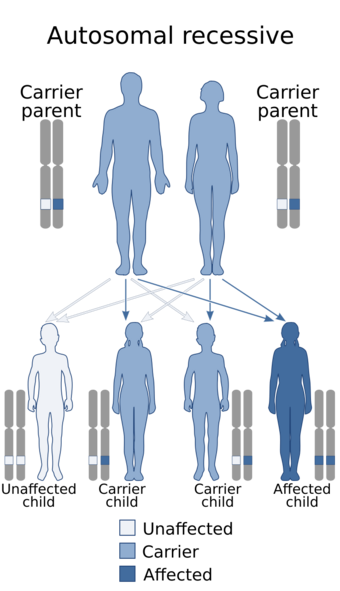Medicine:Autoimmune polyendocrine syndrome type 1
| Autoimmune polyendocrine syndrome type 1 | |
|---|---|
| Other names | Autoimmune polyendocrinopathy-candidiasis–ectodermal dystrophy/dysplasia (APECED),
Autoimmune polyglandular syndrome type 1, Whitaker syndrome, Candidiasis-hypoparathyroidism–Addison's disease syndrome |
 | |
| Autoimmune polyendocrine syndrome type 1 is autosomal recessive | |
| Specialty | Endocrinology, medical genetics |
| Symptoms | chronic mucocutaneous candidiasis |
| Causes | mutation in AIRE gene |
| Diagnostic method | CT scan, biopsy |
| Treatment | hormone therapy, antifungals, immunosuppression |
Autoimmune polyendocrine syndrome type 1 (APS-1), is a subtype of autoimmune polyendocrine syndrome (autoimmune polyglandular syndrome). It causes the dysfunction of multiple endocrine glands due to autoimmunity. It is a genetic disorder, inherited in autosomal recessive fashion due to a defect in the AIRE gene (autoimmune regulator), which is located on chromosome 21 and normally confers immune tolerance.[1][2][3]
Signs and symptoms
APS-1 tends to cause severe symptoms.[4] These are present from early in life, usually around 3.5 years of age.[4] Common symptoms of APS-1 include:
- Chronic mucocutaneous candidiasis.[4]
- Hypoparathyroidism.[4]
- Addison's disease.[4]
- Ectodermal dystrophy (skin, dental enamel, and nails).
APS-1 may also cause:
- Autoimmune hepatitis.[4]
- Hypogonadism.[4]
- Vitiligo.[4]
- Alopecia.[4]
- Malabsorption.
- Pernicious anemia.
- Cataract.
- Cerebellar ataxia.[5]
Cause

APS-1 is caused by a mutation in the AIRE gene, encoding a protein called autoimmune regulator. This is found on the 21q22.3 chromosome location, hence chromosome 21.[1][2][6] The AIRE gene may be affected by any of at least 186 mutations.[7] APS-1 may be inherited in an autosomal recessive manner.[8]
Different mutations are more common in different geographic regions. R139X is a common mutation in Sardinia.[4] R257* is a common mutation in Finland .[5] Both of these mutations are nonsense mutations: the asterisk and the "X" both indicate a stop codon.[7] A 13-base-pair deletion in the AIRE gene, c.967-979del13bp, has been identified in APS-1 patients in Norway , Britain[8] and North America.[9][10]
Pathophysiology
APS-1 is due to problems with immune tolerance.[11] APS-1 causes considerable reactions with both interferon omega and interferon alpha.[4][12] There may also be a reaction against interleukin 22.[4] This leads to damage to endocrine organs.[4] Common problems include hypercalcaemia and nephrocalcinosis (due to a lack of calcitonin from the thyroid), and pituitary problems (such as growth hormone deficiency).[4] Antibodies against NLRP5 may lead to hypoparathyroidism.[citation needed]
Diagnosis

Diagnosis of APS-1 is based on a number of tests, including endoscopy, a CT scan,[12] a biopsy (with histological testing),[12] and serum endocrine autoantibody screening.
Treatment
Autoimmune polyendocrine syndrome type 1 treatment is based on the symptoms that are presented by the affected individual. Treatments may involve hormone therapy,[13] systemic antifungal treatments,[4][13] and immunosuppression.[13]
History
APS-1 may also be known as autoimmunity endocrinopathy candidiasis ectodermal dystrophy / dysplasia (APECED),[citation needed] autoimmune polyglandular syndrome type 1,[citation needed] Whitaker syndrome,[12] or candidiasis-hypoparathyroidism-Addison's disease syndrome.[14]
See also
References
- ↑ 1.0 1.1 "AIRE gene". https://ghr.nlm.nih.gov/gene/AIRE#location.
- ↑ 2.0 2.1 "APECED". https://ghr.nlm.nih.gov/condition/autoimmune-polyendocrinopathy-candidiasis-ectodermal-dystrophy#inheritance.
- ↑ Shoenfeld, Yehuda; Cervera, Ricard; Gershwin, M. Eric (2010-06-08). Diagnostic Criteria in Autoimmune Diseases. Springer Science & Business Media. p. 265. ISBN 9781603272858. https://books.google.com/books?id=A_vtzMxtd9AC&q=autoimmune+polyendocrine+syndromeS&pg=PA265.
- ↑ 4.00 4.01 4.02 4.03 4.04 4.05 4.06 4.07 4.08 4.09 4.10 4.11 4.12 4.13 4.14 Meloni, Antonella; Willcox, Nick; Meager, Anthony; Atzeni, Michela; Wolff, Anette S. B.; Husebye, Eystein S.; Furcas, Maria; Rosatelli, Maria Cristina et al. (April 2012). "Autoimmune Polyendocrine Syndrome Type 1: An Extensive Longitudinal Study in Sardinian Patients". The Journal of Clinical Endocrinology & Metabolism 97 (4): 1114–1124. doi:10.1210/jc.2011-2461. ISSN 0021-972X. PMID 22344197.
- ↑ 5.0 5.1 Orlova, Elizaveta M; Sozaeva, Leila S; Kareva, Maria A; Oftedal, Bergithe E; Wolff, Anette S B; Breivik, Lars; Zakharova, Ekaterina Y; Ivanova, Olga N et al. (2017-07-20). "Expanding the Phenotypic and Genotypic Landscape of Autoimmune Polyendocrine Syndrome Type 1". The Journal of Clinical Endocrinology & Metabolism 102 (9): 3546–3556. doi:10.1210/jc.2017-00139. ISSN 0021-972X. PMID 28911151.
- ↑ "Autoimmune Polyglandular Syndrome Type 1 (APS-1)". NIH: National Institute of Allergy and Infectious Diseases. https://www.niaid.nih.gov/diseases-conditions/autoimmune-polyglandular-syndrome-type-1-aps-1.
- ↑ 7.0 7.1 D.N. Cooper; E.V. Ball; P.D. Stenson et al., eds. "AIRE". Institute of Medical Genetics in Cardiff. https://www.hgmd.cf.ac.uk/ac/gene.php?gene=AIRE.
- ↑ 8.0 8.1 "A Common and Recurrent 13-bp Deletion in the Autoimmune Regulator Gene in British Kindreds with Autoimmune Polyendocrinopathy Type 1". American Journal of Human Genetics 63 (6): 1675-1684. 1998. doi:10.1086/302145. PMID 9837820.
- ↑ "AIRE-mutations and autoimmune disease". Current Opinion in Immunology 43: 8-15. 2016. doi:10.1016/j.coi.2016.07.003. PMID 27504588.
- ↑ "A novel AIRE mutation leads to autoimmune polyendocrine syndrome type-1". Frontiers in Cell and Developmental Biology 10. 2022. doi:10.3389/fcell.2022.948350. 948350. PMID 36072346.
- ↑ "APECED: A Paradigm of Complex Interactions between Genetic Background and Susceptibility Factors". Frontiers in Immunology 4: 331. October 2013. doi:10.3389/fimmu.2013.00331. PMID 24167503.
- ↑ 12.0 12.1 12.2 12.3 Aldasouqi, Saleh A. (15 November 2016). "Type I Polyglandular Autoimmune Syndrome". Medscape. http://emedicine.medscape.com/article/124183-overview.
- ↑ 13.0 13.1 13.2 INSERM RESERVED. "Orphanet: Autoimmune polyendocrinopathy type 1" (in en). http://www.orpha.net/consor/cgi-bin/OC_Exp.php?lng=en&Expert=3453.
- ↑ Greenspan, F. S.; Gardner, D. C. (2004) (in en). Basic clinical endocrinology. New York City: McGraw-Hill. pp. 103. ISBN 978-0-07-140297-2. https://archive.org/details/isbn_9780071402972/page/103.
Further reading
- "Novel Findings into AIRE Genetics and Functioning: Clinical Implications". Frontiers in Pediatrics 4: 86. 1 January 2016. doi:10.3389/fped.2016.00086. PMID 27597936.
- "Autoimmune polyendocrinopathy candidiasis ectodermal dystrophy (APECED): a model disease to study molecular aspects of endocrine autoimmunity". Clinical and Experimental Immunology 135 (3): 348–57. March 2004. doi:10.1111/j.1365-2249.2004.02384.x. PMID 15008965.
- "Autoimmune polyendocrinopathy candidiasis ectodermal dystrophy: insights into genotype-phenotype correlation". International Journal of Endocrinology 2012: 353250. 2012. doi:10.1155/2012/353250. PMID 23133448.
External links
| Classification | |
|---|---|
| External resources |
 |

